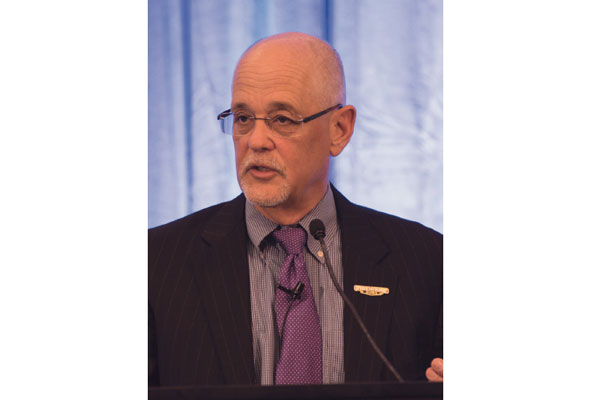As many chain restaurants face flat or declining traffic, Firehouse Subs bucked industry trends last year with gains in average unit volumes and overall traffic, which CEO Don Fox attributed exclusively to a thriving off-premises business. With a phalanx of headwinds blowing into the restaurant world, Fox predicted a coming shakeout between restaurant brands and their delivery partners because of financial arrangements he termed unsustainable.
Firehouse Subs, the 116th largest U.S.-based franchise system by sales, grew its traffic 4 percent in 2018, which Fox said is a “5 percent spread” compared with the wider restaurant industry. Without delivery, as well as a growing takeout business, the CEO said the chain would have lost sales, rather than growing during 2018.
Boosting off-premises channels is the company’s highest priority this year after its more than 1,100 U.S. locations executed several programs intended to improve the experience for diners that order ahead and pick up food, or have their meals delivered through third-party delivery services.
Compared with some brands such as McDonald’s or Chipotle, which signed exclusive partnerships with a single national delivery platform, Firehouse leaves the decision up to its franchisees, but encourages them to use as many services as possible. That hands-off stance is based on Fox and his management team’s belief that delivery customers first decide which service to use before picking the type of cuisine or specific restaurant from which they’d like to order.
“My hope is it evolves to being exclusively brand-first even though they’re using the third-party channel, but I think we’re still a year or two away from many brands arriving at that point,” he said.
Rather than pointing to an increase in delivery orders across the industry, Fox said the “real story” in his segment of the restaurant business is the decline of dine-in business due to a sea change in customer behavior. He stressed that his point of view isn’t just a matter of semantics, citing an example of one of its markets were comparable sales were up 8 percent year-over-year, but dine-in sales declined.
To make the most of its outside-of-the-restaurant sales, Firehouse implemented a “Rapid Rescue” program to holistically improve the quality of its off-premises dining experience that included dedicated pickup racks for customers and delivery providers and also improving its packaging for hot sandwiches, which tended to arrive soggy in early tests.
Its new packaging is based on a sugarcane derivative that’s biodegradable, has good thermal properties and handles moisture from steaming-hot sandwiches better than its previous, foil-based product.
“I can’t shoehorn people into a seat if that’s not where they want to be,” Fox added. “Because of the other factors that go into their decision process, it was imperative that we closed that quality gap” for off-premises diners.
Beyond the Rapid Rescue
With years of delivery experience under the belts of Firehouse franchisees, the company said its internal studies have shown declining incrementality from delivery sales, meaning that brands posting big delivery gains are likely stealing market share from competitors, rather than the restaurant industry expanding as a whole. This dynamic, he added, suggests the current landscape is set to keep shifting for restaurant operators.
“While your third-party business may continue to grow, the relationship to overall comp sales does not remain the way it was at the outset, so you don’t have to be Sherlock Holmes to deduce that there’s some shifting going on with their normal customer base over time and that has the potential to create an unfavorable situation,” Fox said.
Calling industry-wide traffic numbers a red flag, he said declining traffic proves that third-party delivery services haven’t brought new customers or sales into the industry, but rather is “shifting the share around” to benefit brands that are investing in a better experience for their off-premises customers.
“If you haven’t added any visitation to the industry but you’ve imposed this layer of cost to the restaurant operator, that is not sustainable over time,” Fox added.
As industry watchers reacted to an unusual press release from Jimmy John’s in which it announced it was permanently swearing off third-party delivery services—for a brand with its own in-house drivers—Fox speculated that an increase in competition for one of its biggest competitors has “upset the apple cart” that provided an opportunity for the company to underscore its “freaky fast” marketing message.
“They want to control the quality, etcetera, even though with cold subs there’s not a lot you can mess up,” he quipped.
At present, a handful of company-owned Firehouse Subs locations offer in-house delivery, and Fox said that he remains “open minded” about expanding his own delivery fleet in the future, adding that staffing difficulties remain the biggest reason not to go that route.
To offset the financial stress for the brand’s franchisees, Firehouse has offered recurring but temporary delivery fee rebates to encourage participation in third-party off-site delivery and reduce the fees franchisees pay out of their own pockets.
Aside from programs already in place, periodic reassessment and a constant eye on shifting trends, Fox said “our existing customers know it’s a better experience when they come in the dining room, but the other things in their life are driving them to want the off-premises.”


